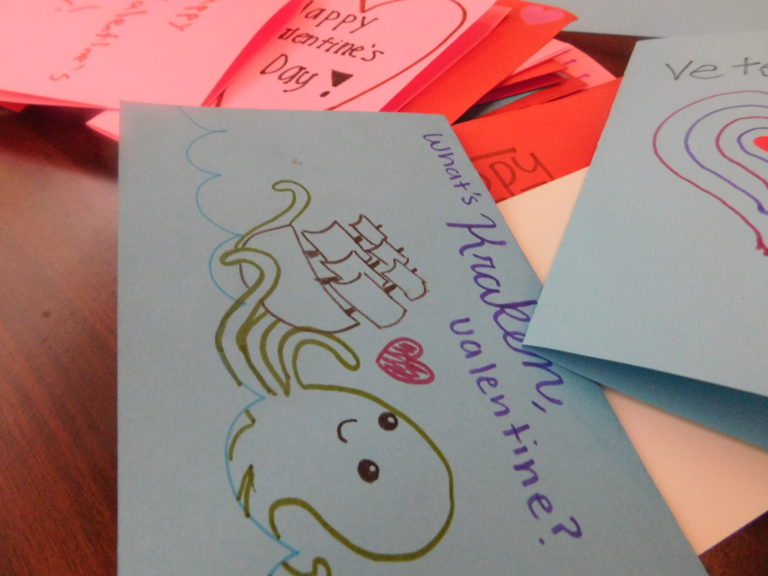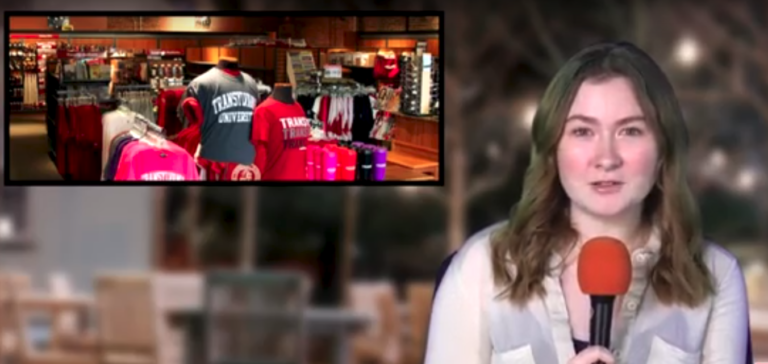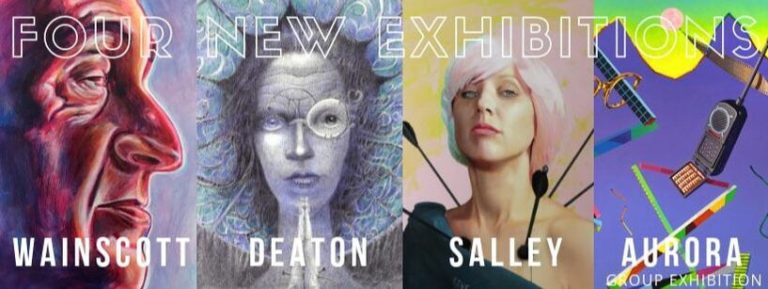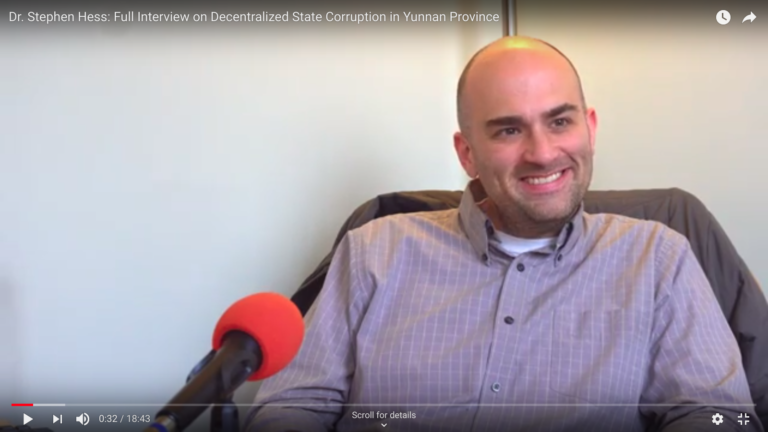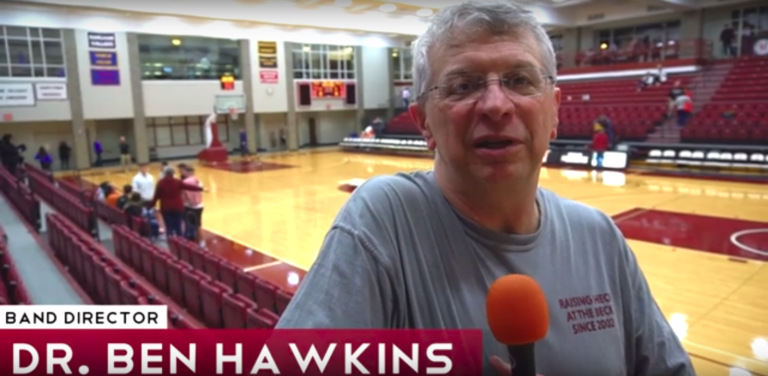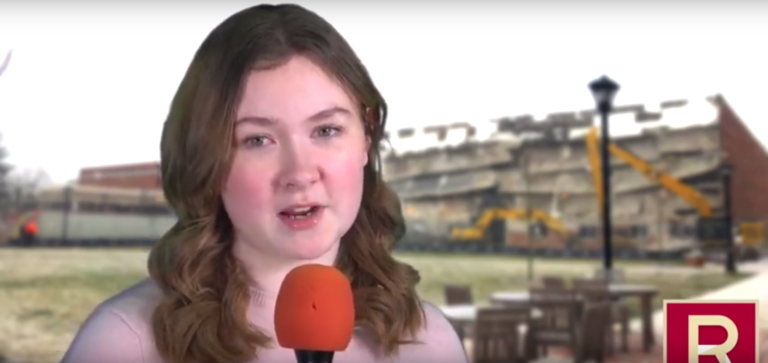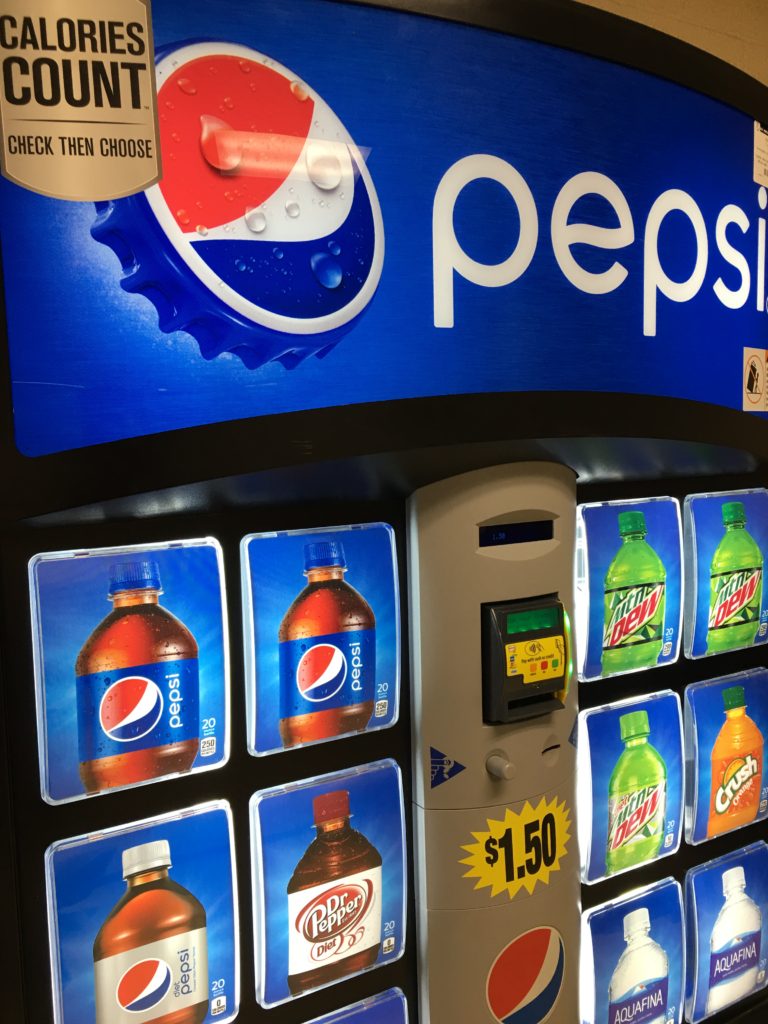The Valentines for Vets event was planned by a group of RAs in collaboration with Military Mission and Lady Veterans Connect. Transy students were invited to Rosenthal Commons to make valentines for active duty military members and local veterans Friday evening.
Weekly Blog & Playlist: Valentine’s Edition
Hey, Y’all!
Happy Friday and happy *almost* Valentine’s Day! Whether you’re celebrating with a partner or your pals, this playlist is sure to get you in the mood for love! If you’re not into the holiday, that’s okay, because I included some breakup songs too. As always, feel free to email me video suggestion’s for next week’s playlist to tmahlinger20@transy.edu!
This music video premiered less than 24 hours ago around the same time that Ariana dropped her new album, and is currently #1 on YouTube’s trending videos with over six million views. Twitter has been buzzing all day with mixed reactions to the plot twist ending of this video, so watch it and let me know your thoughts!
“LOVE” by Kendrick Lamar was one of my favorite songs off his album DAMN. from 2017. The music video offers an intimate take on the stages of a relationship from the beginning to what seems like the end, all from the perspective of a dining room table.
This video is a major throwback to the good old days back in 2011. Fourteen-year-old me was blasting this song on repeat (and eight years later, I still do).
“I Bet” by Ciara is an iconic breakup song that was released in 2015. The song’s powerful lyrics are relatable and poignant with just the right amount of simple yet emotional imagery.
Their Superbowl halftime show might’ve received mixed reviews, but who doesn’t love a good Maroon 5 throwback? This music video was released in 2005, which is the same year YouTube was founded. Feel old yet?
Stay chill,
Taylor
Sunday, February 10th @4pm, MFA Carrick Theater
There will be a sextet from the University of Louisville called Les Six visiting campus to perform a concert, including an original piece by our own Dr. Larry Barnes!
Thursday, February 14th @ALL DAY
HAPPY VALENTINE’S DAY!!! <3
Gallery Review: Four Exhibitions at the Lexington Art League
The Lexington Art League’s current solo exhibitions are Return From Exile by Clay Wainscott, First World Allegory by Benjamin Salley, and The God Burden by Susan Deaton.
The Art Leage also currently has a group exhibition, Aurora, which is curated by Samantha Simpson and includes works by Natalie Baxter, Adrienne Dixon, Lori Larusso, Joe Pushel, T. Michael Martin, and John Harlan Norris.
I visited Loudoun House, a Gothic revival villa, on a chilly, golden, January evening. There were no other gallery-goers, so the creak of the floorboards under my feet was especially pronounced. Inadvertent or not, this is an excellent way of tracking the movements of visitors as they appreciate the art.
My path began with Clay Wainscott. His paintings glow from within as if neon is mixed into the acrylic. His piece Wet Country Road captures the dull dreariness of a cloudy drive down a slick back road while simultaneously charging the scene with energy.
Wainscott’s stylistic evolution is clear throughout the exhibit. I started with his Self Sans Hands, an acrylic painting done in 1991. His newer pieces are brighter and glossier; they are much less textured than his self-portrait, which has a smeared effect. It seems he has returned from exile with a vengeance.
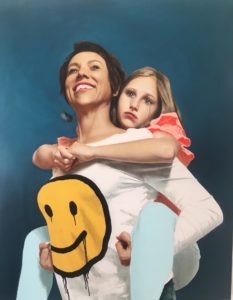
Benjamin Salley’s Volunteer depicts a mascara-smudged, fur-coat-wearing, toy-dog-clutching woman. Her shirt reads “I VOLUNTEER”, a sentiment echoed by the crown of thorns that digs into her dye job. In this painting, Salley is making a satirical jab at the sect of individuals whose mission it is to fix our woebegone and broken world as ostentatiously as possible with a self-victimizing air.
Contradiction also exists in Salley’s Child Support, an oil painting done on panel. Featured is a smiling woman with a crying girl riding piggyback behind her. Even the woman’s shirt is a smiley face, though its eyes and mouth are dripping with black ink, mirroring the child’s tears. It seems that despite appearances, the child isn’t receiving the support she needs.
Warehouse, by Susan Deaton, is a ballpoint pen piece that shows a raven gliding over a sea of mask-like faces. In her artist statement, Deaton discusses her Catholic upbringing, which she has abandoned, and the problems she now has with Christians who twist God’s words to hurt others. The raven could be death, choosing who to select next from the sea. Everyone’s eyes are closed to the suffering of the world.
Aurora invokes color to “affect one’s mood and alter perceptions.” An example of this is Lori Larusso’s Conciliatory Cake Slice, which depicts a chunk of store-bought cake in an open plastic container, left sitting out on a vast green surface. It feels forgotten.

Speaking of forgetfulness, Joe Paushel’s Wearing All That We Had has certainly never misremembered anything. It is a ceramic head with a towering brain or brain-like headdress. The point seems to: In the end, we only have what’s in our minds.
Each piece in the exhibitions is steeped in allegory, color, or political commentary. There is something for everyone, so bring a friend and make your way over to Loudoun House. They are open every day but Monday and don’t close until 8 pm on Fridays. Get out there and look at some art! It’s good for you.
Rambler Weekly Blog & Playlist: February 1st
Hey Y’all!
Happy February! This week might’ve been chilly, but I found some hot beats that will be sure to warm you up. All three of the videos I chose for this week dropped within the last three days and are currently trending on YouTube. Email me some good music video suggestions at tmahlinger20@transy.edu and watch for them in next week’s blog!
Sam Smith has done it again with a beautiful single called “Dancing With A Stranger” featuring former Fifth Harmony member Normani. The single has been out for a couple of weeks with the video debuting not far behind it. The moody music video has already gained over 4 million views in just three days and is currently trending on YouTube. The video captures Smith and Normani as they dance around a light, spacious house with shadows fading in and out of the picture. To say that this song and video are a total mood is an understatement.
Billie Eilish released her new single “bury a friend” the same day the music video dropped. The song is a seriously creepy detour from what her style as an artist was last year, but I’m kinda loving it. Not only does the song have a catchy beat, but the visuals in this video gave me some serious horror movie vibes. The lyrics themselves are haunting too:
“What do you want from me/Why don’t you run from me?
What are you wondering/What do you know?
Why aren’t you scared of me/Why do you care for me?
When we all fall asleep/where do we go?”
The music video had already climbed to #19 on YouTube’s trending music list and the single has accumulated over 6 million streams on Spotify alone. This music video is definitely worth watching if you’re looking for some dark vibes for the weekend and a captivating song.
Nicki Minaj’s music video dropped 24 hours ago and is currently #4 on YouTube’s trending list with almost 2 million views. “Hard White” is one of the songs off her album Queen which was released last year. The music video has stunning visuals, but it’s almost too much. With that being said, there’s already been a lot of drama and speculation surrounding this video, with some fans saying that it is targeted at Drake specifically. What do you think?
Stay toasty,
Taylor
Arts events are slim this week, but that’s okay because we have lots coming up in the following weeks.
MFA Morlan Gallery
If you haven’t seen it yet, the fabulous Data, Mine exhibit in Mitchell Fine Art’s Morlan Gallery will run through Feb. 19th, so there’s still time! The gallery hours are weekdays from 12pm-5pm.
Thursday, February 7th @3pm, Cowgill 102
Jami Hogan-Gormley will be giving a talk about how arts is useful in her career as creative strategist at Campbell’s Soup.
Transy Women’s Hoops cracks D3 Top 25; Fulks Secures 100th Win
Transy Women’s Hoops has been on an absolute tear as of late. The Pioneers are an impressive 17-2 with a 10-1 record against conference opponents. They are currently sitting atop the Heartland conference. In the most recent NCAA poll, they are ranked 25th. This is the first time Transy has been ranked in four years. The Jan. 19 home victory against Bluffton secured Coach Fulks’s 100th win as the head coach of the program.
In the home victory against Bluffton, it was junior forward Shelby Boyle leading the charge with a 25 point performance, her best scoring output of the season thus far. She also led the team with six assists. Her teammate, Miranda Otero, did a fantastic job controlling the paint with a game-high of 13 rebounds. Transy came out roaring in the first quarter going up by 12 points and did not back down.
The following Wednesday the Pioneers traveled to southern Indiana to face their bitter rivals, the Hanover Panthers. The Pioneers came out victorious in a tough road environment with a score of 78-70. This game became Ashton Woodard’s turn to step up with a double-double scoring 19 points and collecting 10 rebounds to lead the team in both categories. Boyle had another impressive performance coming one rebound shy of a double-double herself finishing with 16 points and nine rebounds.
On Saturday, the Pioneers took on the Rose-Hulman Engineers at home and put on a defensive stand against the Engineers. The Pioneers earned yet another victory by a score of 61-47. They held the Engineers to just 34% shooting from the field and secured the season sweep of Rose-Hulman following a win against them earlier this season. Guards Celia Kline and Zenoviah Walker both scored 13 points to propel the Pioneer offense to a win.
Our Pioneers are absolutely rolling right now and are currently on a 12-game winning streak. With some great leadership from Coach Fulks and team leaders paired with such a balanced scoring attack, the Pioneers will be a tough opponent for any team they face this season. This team has worked incredibly hard on this history-making season, and the team is just getting started. On Wednesday night at 7:00 pm, Transy Women’s Hoops are looking to extend that streak to 13 at the Beck Center as they take on Earlham.
Transy switches from Coke to Pepsi Contract
When students returned to campus at the start of the new semester, they were met with a new partner: PepsiCo.
As of Jan. 1, 2019, Transylvania partnered with the soda giant and began the sale of their products at dining facilities and vending machines across campus. The switch comes after seven years of partnering with Coca-Cola, the major competitor of Pepsi.
Transy partners with hundreds of vendors to provide products for the community. Contracts with vendors are rebid when a customer, Transy for example, listens to a company’s pitch for a specific product. The agreement with Coke lasted seven years, which is a longer contract than most according to University Vice President of Finance and Business, Marc Mathews. Unlike many contracts the school enters, the bidding pool for this particular contract is low: just Pepsi and Coke. Both companies bid on the contract.
According to Mathews, the items factoring into the consideration of bids include:
“1. Service – primarily accessibility, responsiveness and on-time delivery of fountain service (Jazzman’s and the Raf) and vending machines.
2. Coverage – willingness to locate beverage service in many locations to provide hospitality on campus.
3. $$$$$$$$$”
Specific details of the offers from both vendors are confidential, but Mathews affirms “that Pepsi’s offer was the best for the institution” when weighing the three factors.
The bid with Pepsi will last five years but can be canceled during the contract period for poor performance. The contract is able to be renewed for five one-year terms.
After switching to Pepsi products, Transy now offers Rockstar energy drinks, Starbucks coffee, Pepsi, Mountain Dew, Dr. Pepper, Aquafina, and others.


